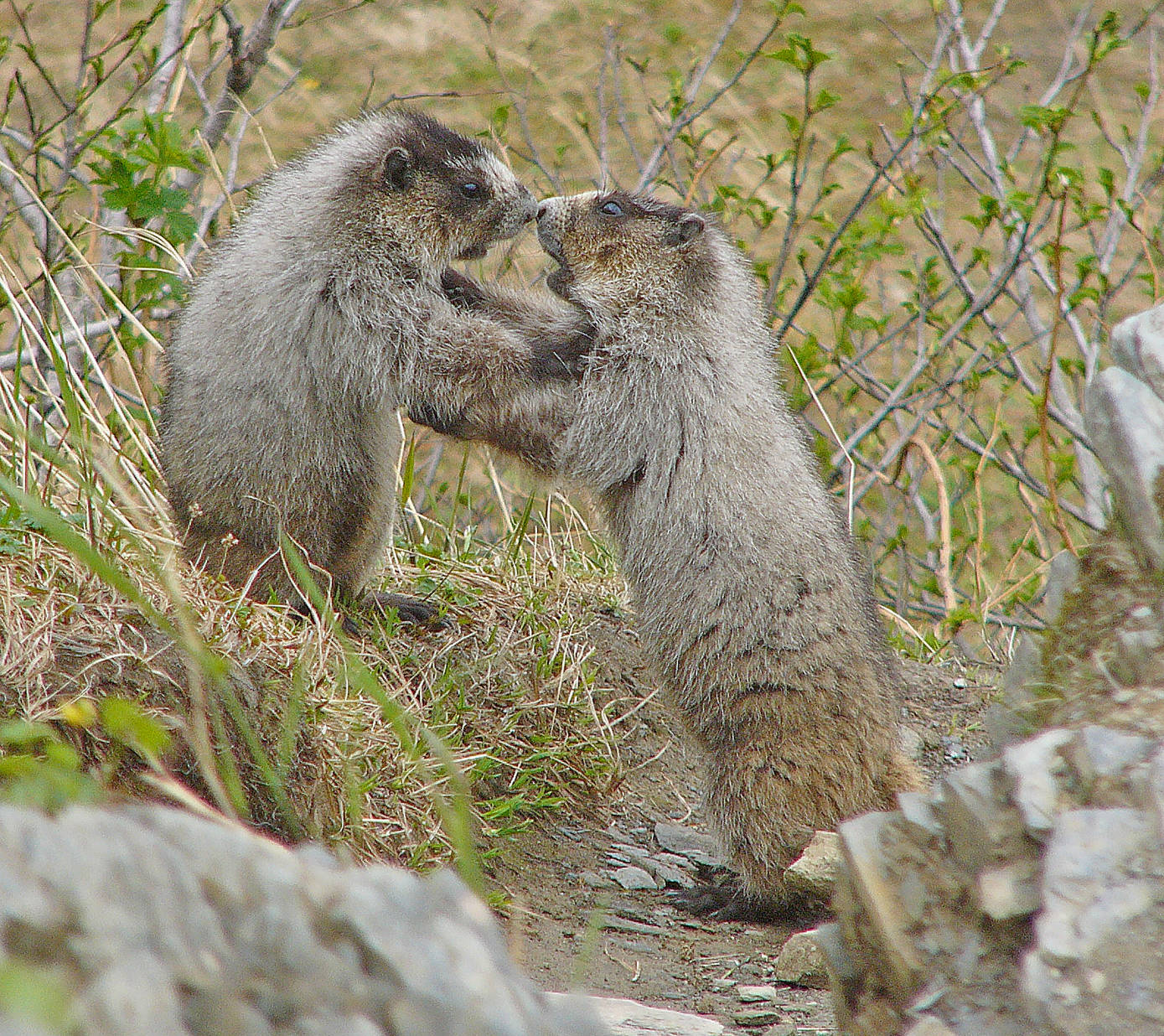Any observant dog owners can recognize the invitation-to-play posture of their dogs, sometimes addressed to persons, and sometimes to other dogs.
Surely none of us doubts that dogs love to play, with balls or sticks or each other. And cat owners watch their feline friends toss and chase toy mice, frolic with rumpled scatter rugs, and push pingpong balls under the couch only to fish them back out again. A favorite trick of some cats is ‘ambush,’ running ahead of a person or another cat, hiding behind a door, and pouncing out as the victim passes by. Some cats and dogs even know how to make jokes, sometimes deliberately and mischievously misleading their humans or each other in frivolous ways. Of course, dogs and cats are domestic critters, which often have lots of time for frolicking, because they usually don’t have the need to find food or escape from enemies or find mates; the same is true for animals in captivity, which often need sources of amusement.
What about animals in the wild? Do they play too? Sure; especially younger ones, but adults too. Wolves and coyotes tussle and chase. They use the same play-invitation postures among themselves as dogs do; our late-lamented black wolf, Romeo, used to invite passing dogs to play. Online sources offer plenty of examples: Young elephants mud-sliding and mud-wrestling or macaques repeatedly leaping from a tower into a pool of water or … you name it.
Play behavior often has some utilitarian physiological functions, such as muscle toning or sharpening reflexes or improving coordination. It can also have useful social functions, such as learning the rules of interaction among members of a group (e.g., don’t play too roughly!) or establishing a dominance order. But play behavior would not be so common among critters if it weren’t simply FUN.
It took a long time for humans to recognize that animals, both domestic and wild ones, like to have fun. Having fun requires a degree of intelligence that humans have been slow to admit is found in animals — irrationally and wrongly preferring to think ourselves superior to everybody else.
Here are a few examples of animals that play, mostly from animals that we often see around here.
Young marmots box and wrestle on the threshold of their den. Bear cubs tumble and tussle with each other, sometimes engaging mama as well; so do beaver kits and young ones of many other species. Mountain goat kids sometimes bounce from ledge to ledge, apparently just because they can and it is fun.
Juvenile humpback whales sometimes cavort, exuberantly slapping their flukes and their pectorals, and then breaching, as if saying ‘Hey mom, look at me!’ A local photographer watched one breach seventeen times in quick succession!
We can see ravens having fun. They might fly up with a feather or some other object, and then drop it, only to swoop down and catch it again; or maybe a friend would dart in to snatch it away. Sometimes there is a game of keep-away: I’ve got a toy, you try to get it from me. We’ve watched ravens roll down a snowy slope, or slide like a toboggan, only to trot back up to the top and do it over again.
Crows play, too. There is an online video of a European crow sliding down a snowy roof while standing on a plastic lid; then it picked up the lid, went back to the top of the roof, and slid down again. What a hoot! (I couldn’t leave that one out, even though it is not local). Our northwestern crows sometimes dangle upside down from a branch, not reaching for anything nor avoiding something, just showing off. The biggest showoffs dangle on one foot: see what I can do! Then they may swing back upright with a wing flap or two, or let go and try it again on a different branch.
Otters slide down muddy or snowy slopes. Some slide tracks are many yards long, and the otter then continued onward to wherever it was going. This is an energy-efficient mode of transportation — just push off and let gravity do the rest. But sometimes they are not really going anywhere, just down a small slope and back up again to do it all over once more. Sometimes a whole slope will be covered with their slide marks. It must be fun!
Dall’s porpoises sometimes come to ride the bow wave of a fast-moving boat. A little group of them seems to appear from nowhere and together they ride that wave, sometimes for a considerable distance. Then they are gone as suddenly as they came. It’s all in fun.
One day at Eaglecrest I found a place where ptarmigan had pranced around, leaving lots of footprints. These were interspersed with a number of slide marks, about three feet long, going down a little slope. We know that ptarmigan often glide to a stop when they come in for a snow-landing, leaving a short slide mark, but the marks I saw did not look like landing marks. They made me think of the otter slides, so I wondered if ptarmigan can play too. I turned up only one report, which says that flocks or family groups of willow ptarmigan frolic together, crouching low with head extended, jumping around, and flapping one or both wings. I would love to see that!
• Mary F. Willson is a retired professor of ecology.

